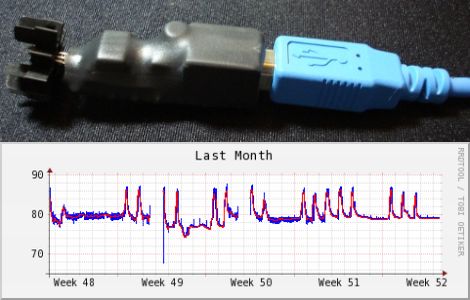

[Dan’s] office is awfully hot, but he needed some real temperature numbers that he could show the building management office to justify opening a maintenance ticket. He had seen some simple temperature probe examples online, and decided to build his own using a small AVR chip.
Based off a similar temperature monitoring example called EasyLogger, his temperature probe uses an LM34 temperature sensor, which is wired to an ATtiny45. The ATtiny communicates with his computer using the Ruby-USB library in conjunction with a bit of Ruby code he put together. Once the data is obtained, all of the temperature measurements are logged and graphed using RubyRRDTool.
As you can see by in the image above, his office is far hotter than it should be, so we’re pretty sure he’s happy to have actual measurements to back up his claims.
If you are looking to make a small temperature probe of your own, his code, schematics, and links to all of the tools he used in the project are available on his site.















Interesting graph. If you mentally fill-in the missing data, it looks like Dan’s office temperature spikes up each day for 5 days in a row, then it stays cool for two days, and then repeats.
If it was due to not enough HVAC cooling, then I think we’d also see some slopes due to day/night activity, including weekends. Since there’s no evidence of that, I’d guess the HVAC has plenty of capacity, but is running in a setback mode, and it’s over-heating his office during the “occupied” hours.
He needs to close the vents. :-)
What’s that in? Fahrenheit or Celsius? Rather important to mention, I’d think…
I am guessing Fahrenheit , unless he works in a sauna.Nice,simple and cheap a job well done.
ps:Stick it to the man!
I love it. I have the same problem in my (very new) office. I frequently wonder if I’m having a stroke/fever, or if the HVAC has crapped out/gone haywire again. This is just the sort of build I was looking for. Thanks!
The reason that the temperature peaked during working hours was that there were two humans in the office giving off heat as well as two huge monitors giving off heat. To be fair, I should say that I put the detector somewhat above the monitor (but not directly above it) so the measured temperature was maybe a bit higher than it was where I was sitting. Still was hot as hell though.
Maintenance did fix it to some extent every now and then, but part of the problem was just that we were on the very end of the pipe and so didn’t get as much AC as everyone else. Also, I was running ongoing computations for research on my computer’s idle cycles. Eventually I realized that this contributed significantly to the heat and it ends up that pausing these computations during working hours made a huge difference.
One thing I should mention is that RRDtool has the capability for displaying the charts on a web page. I had a page that showed charts for the year, month, day, and hour.
Fahrenheit? :)
Anyway, here is my ds1820 setup for anyone interested:
http://www.julietmikebravo.nl/index.php/2010/10/04/ds1820-temp-monitoring-using-linux-and-cacti/
Still running, have to repair my aquarium sensor…
It’s ridiculous that you would have to JUSTIFY the fact that you needed more cooling in your office with actual data. You should just be able to have them walk into your office, sweat their balls off, and there’s the proof.
Great implementation anyway, though.